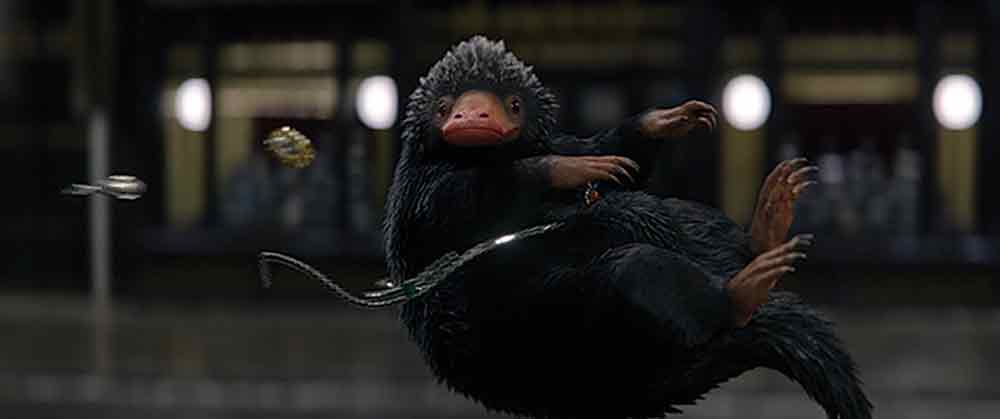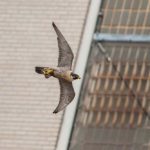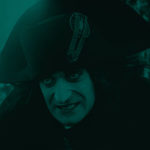
Magic in the Big Apple
Posted on Mar 16, 2017 by Julian Mitchell
DoP Philippe Rousselot talks about how his shooting vision for Fantastic Beasts was based in reality in order to make the fantastical leap out from the grimey streets of New York
” I have to admit to a sense of terror when commencing this project,” begins cinematographer Philippe Rousselot in a moment of patent candour. “Whilst I have worked on a number of large-scale, large-budget movies before, I knew Fantastic Beasts would be a much bigger affair before I had even read the script. But once I had read it, I could see it was going to be absolutely enormous, with lots of key decisions to make and many challenges along the way. Nothing exists, not even the beasts, until a team creates it. That said, I count myself as very lucky to be invited to work on it.”
Directed by David Yates, and written by J K Rowling, the Heyday Films/Warner Bros’ production, Fantastic Beasts and Where to Find Them, is the next instalment in Rowling’s Wizarding World. Fantastic Beasts is the first in a series of five features.
Set in New York in the 1920s, the story follows the adventures of writer Newt Scamander (Eddie Redmayne), who smuggles magical creatures into the USA, where they manage to escape. Scamander seeks to recapture the beasts, which are at risk of being destroyed by the Magical Congress of the USA (Macusa), and gets help from Porpentina Goldstein (Katherine Waterston), a witch working for the Macusa and Jacob Kowalski (Dan Fogler), a No-Maj with no magic.
Philippe shot the $225m movie, releasing in 2D/3D widescreen, IMAX 4K Laser and large-format 70mm film, over a 100-day production period. Whilst the final movie is set amongst the streets and towering skyscrapers of 1920s New York, it was actually shot on a series of vast sets built on the stages and backlot at Warner Bros. Studios Leavesden, and at locations in Liverpool (Manhattan). Philippe had around three months of prep before commencing principal photography.
Given that the cinematographer’s key task is turning the script into moving images, Philippe – whose credits include Charlie and the Chocolate Factory (2005) for Tim Burton, Sherlock Holmes (2009) and Sherlock Holmes: A Game Of Shadows (2001), both directed by Guy Ritchie, and Shane Black’s The Nice Guys (2016) – says he took the only route possible in the circumstance: “To immerse myself very, very slow into the project by talking with all of the key collaborators, and try to enjoy a voyage of discovery.”
 Director David Yates on set with Queenie (Alison Sudol).
Director David Yates on set with Queenie (Alison Sudol).
Port of call
For any cinematographer the first port of call is always the director. “I already knew David after having spoken to him previously about other projects. His drive, knowledge, talent and fantastic kindness throughout the production proved a real blessing,” Philippe recalls.
“Our initial conversations were not definitive statements about doing one thing or another. The most important thing – which David decided from the start, and which we took with us right through production to the final DI grade – was that whilst it’s a fantastical tale, and really quite dreamy in places, it needed to look as real and straightforward as possible. So that, when fantastic things happen, they become all the more powerful and intriguing for the audience.”
Although fully aware of the Harry Potter franchise, Philippe did not reference any of those movies to help inform the look of Fantastic Beasts.
“This was something fresh, of its own, and the task was really to create a new aesthetic,” he says. “Keeping the desire for reality in mind, my inspiration came partly by absorbing the imagery from the huge number of vintage photographs of New York that production designer Stuart Craig and his team of set designers had assembled, as well as scrutinising plans, models and the early set-builds. Also, I know New York myself. The light in Manhattan in the winter is very special, and I wanted to capture the sense of dark contrast there.”
He says that from the outset the inclination of the director and producers was to shoot Fantastic Beasts digitally. Accordingly, he set about making the key decisions about aspect ratio, lenses and camera.
“My push was for anamorphic 2.40:1, which David embraced,” he says. “You tend to use longer focal length lenses in anamorphic, which gives more presence to the actors, and there’s a certain visual poetry to the pictures which I really like. With the widescreen format, the rules of framing and composition are looser too. You can float characters from one side of the frame to the other very pleasingly. Plus you can compose the image with multiple characters, and can catch action in the background or the sides of frame whilst you are focused on the action in the foreground.”
Philippe elected to shoot with G-series anamorphic prime and zoom lenses – and a 180mm E-series prime for long shots, provided as part of an overall camera and lens package by Panavision UK.
“The G-series are compact and the most lightweight of the anamorphics available, so you can use them more comfortably on a Steadicam and on the end of a crane. They also match well with the E-series to retain visual consistency,” he notes.
In terms of the camera choice, Rousselot wanted to shoot with the ARRI ALEXA for a number of different reasons. “I had previously enjoyed a good experience with the ALEXA XT on The Nice Guys – my first movie experience with that camera system. I knew it would perform well with the anamorphic glass, and would cope with the dynamics of the lighting. However, once I had made the base decision about the glass and the camera system, I consulted with my A-camera operator, Des Whelan, about which of the ALEXAs he wanted to use. ”
Whelan’s preference was to shoot with the ALEXA Studio XT as, crucially, it has an optical viewfinder to aid framing. However, to optimise manoeuvrability of the camera/lens when shooting Steadicam, operated by Vince McGahon, and also on equipment, such as Panavision’s pan and tilt head, Rousselot and Whelan opted for the smaller ALEXA XT.
During production the first unit shot with two cameras, with a third always ready to be deployed. The busy second unit – headed by director Stephen Woolfenden, with DOP Jean-Philippe Gossart – was responsible for shooting a wide range of stunt and other action scenes, pick-ups involving the actors and the majority of VFX plates. The second unit also had a trio of camera bodies and anamorphic lenses at its disposal.
The ALEXAs were typically rated at 800 ASA for daylight scenes, and to 1200 ASA for night-time sequences. Philippe says the sensitivity of the camera at these settings delivered no significant aesthetic differences, but perhaps more importantly allowed apertures between T5.6 and T3.5, supporting the work of the focus pullers.
 Pairing the ALEXA XT cameras with G and E-series anamorphic lenses allowed Rousselot to create a credible reality so the fantastical looked just that.
Pairing the ALEXA XT cameras with G and E-series anamorphic lenses allowed Rousselot to create a credible reality so the fantastical looked just that.
A key consideration at a very early stage was the efficient passage of material from set to editorial and the various VFX vendors on the movie. These included Cinesite, Framestore, Double Negative, Method Studios, Moving Picture Company, Rodeo FX and Prime Focus World, which was responsible for the 3D conversion.
“Of course, the magical creatures and beasts in the movie were going to be brought to life separately by different CG teams, and there was going to be a lot of other additional digital manipulation of the image downstream, such as set extensions and other enhancements,” says Rousselot. “So we shot uncompressed ARRIRAW to provide the various post-production departments with the very best image quality that the ALEXAs
can produce.”
The ALEXA XT features a built-in Codex recording to the XR capture drives, supported by Codex’s camera-to-post workflow system, enabling transfer of ARRIRAW material from the set to Technicolor, which set up a dailies processing suite on site. Using the Codex capture drive dock, the team at Technicolor provided backup, cloning, QC, archiving, Anamorphic de-squeeze from the 4:3 ARRIRAW footage, colour management, asset distribution as well as dailies grading. Peter Marsden performed on-set DIT duties during production.

Regarding his collaboration with Tim Burke and Christian Manz, the joint visual effects supervisors, Philippe remarks: “Their task was more enormous and more challenging than mine, and we kept up a constant communication. I was very impressed with their creative and organisational skills in dispatching the VFX shots to the many different vendors on the show, and the impressive turnaround times they encouraged.”
An additional, equally important collaborator in Philippe’s incredible jigsaw was Technicolor’s supervising visual colourist, Peter Doyle. Along with performing the eventual DI grade, Doyle worked with Philippe during pre-production to implement a best-light viewing LUT for the dailies, and to establish a secure colour pipeline into post-production. On-set grading was performed using Pomfort Live Grade, with the CDL passed from set post on a USB-drive, where the settings were relinked with the dailies.
On the physical side of the production Philippe admits to being wowed by the size, scale and beauty of the sets designed by Stuart Craig, as well as the exquisite wardrobe produced by costume designer Colleen Atwood, both triple-Oscar winners.
However, he says, “You can’t wait to have sets built before you set your lights. During prep I considered the set plans and models carefully and then liaised with my gaffer, Chuck Finch and his team of sparks, about the lighting I wanted and where the fixtures would be placed. I went with normal tungsten illumination, and the intention of keeping it real.
When production started I would take a few minutes each day to walk over to the set-builds on our up-and-coming schedule to assess progress, measure the lighting and give my instructions to the rigging gaffer as to any changes – so we would be ready to shoot the next sets without many lighting adjustments being needed.”
Nearly all the visual effects sequences were previsualised by Nvizage, the UK’s first previsualisation company. “These were a very useful reference, and the data about lenses, focus and height of the camera, is very good these days,” remarks Philippe. “But your representation of them on-set does have to be exact. They are like sheet music – you get the notes, but it’s up to you, the cinematographer, to bring the visual images to life.”

Home straight
Philippe completed final DI grade on Fantastic Beasts with Peter Doyle at Technicolor Soho, over the course of two sessions, each lasting around a fortnight, due to the ongoing delivery of final visual effects shots.
“The DI was about us finding the right moods and colours and applying them across the work with consistency,” he says. “Believe it or not, although we started by going back and forth a little bit using some of the grades from the set, we actually went back to the original ARRIRAW files and started the DI grade from there. However, Peter is a master, and it was all pretty straightforward.”
Peter separately graded all the other deliverables, including the Dolby Vision, IMAX and 3D masters, as well as a 70mm print for limited cinema release, which Philippe says “looks really lovely”.
Reflecting on his experience on Fantastic Beasts, Philippe readily acknowledges that it is thanks to the many collaborations he enjoyed with consummate professionals that his initial terror eventually melted away.
“Making a movie is always a team effort,” he observes, “and I am glad to say the combined result of those efforts is a most charming movie.”
 Newt Scamander (Eddie Redmayne) arrives in New York with his fantastic beasts.
Newt Scamander (Eddie Redmayne) arrives in New York with his fantastic beasts.
How The Workflow Was Tamed
The on-set digital workflow for Fantastic Beasts and Where to Find Them was supervised by Peter Marsden, the DIT.
Working closely with Technicolor, who provided an overall dailies, deliverables and DI package to the production, Peter was responsible for the safe capture and delivery of the ARRIRAW camera original files – emanating from multiple ARRI ALEXA XT cameras shooting on the first unit – into post-production. He worked in tandem with second unit DIT Mustafa Tyebkhan, which employed identical workflow procedures from multiple ALEXA cameras. The production shot Anamorphic in the ALEXA’s 4:3 mode (1.33:1 gate /2880×2160) for a 2.40:1 extraction in post-production.
Peter started his DIT career in 2006, and his extensive credit list encompasses independent and major motion pictures, including this year’s Miss Peregrine’s Home For Peculiar Children, using Codex recording and workflow systems. His first experience with Codex was on a Spanish production called 14 Days With Victor.
His first Codex/ARRI ALEXA experience came on director Mike Leigh’s short film, A Running Jump, commissioned for the 2012 Olympics, using the then brand-new ALEXA, fitted with a Codex On-Board M recorder to record the ARRIRAW.
“As time has progressed Codex’s recording technology has gotten faster and more compact, shrinking from external recording technology to the integrated XR Capture Drives within the camera body today,” he says. “This advance is a great aid to camera crews and productions in general, as all of the cabling and external technology has gone, and the recording capacity has increased. These days, people just don’t have to think about the recording system now that Codex is inside the camera, which is the way it should be.”
During production for Fantastic Beasts, Codex XR Capture Drives
were delivered to Technicolor, which had set up a dailies review and data processing facility in some nearby offices on the lot, every lunchtime and every evening on wrap. The Technicolor team included technical operations manager Chema Gomez and dailies colourist Mel Kangleon.
Using a Codex Thunderbolt dock and the Codex Virtual File System (VFS) to specify the ARRIRAW files, the Technicolor team performed cloning and QC tasks before archiving to LTO-tape backups. With copies made and verified, Technicolor then performed the anamorphic 2.40:1 extraction, and made the various deliverables for dailies review, editorial and the VFX vendors on the production. Once the necessary copies and checks were complete with verified clones, the Capture Drives were cleared and returned to the DITs on set ready for recycling into production for the next stage of shooting.
 A Niffler, one of the beasts created for the film.
A Niffler, one of the beasts created for the film.
A single Codex 512GB XR Capture Drive provides around 35 minutes of ARRIRAW anamorphic capture. Fantastic Beasts used 30 Codex XR Capture Drives, across the first and second units, which Peter says was more than enough to run an efficient workflow during the normal course of events, and meant there was always enough capacity on a big day.
Technicolor implemented a ‘best-light’ LUT on-set, and the results of any on-set grading, using Pomfort Live Grade, were parsed as a CDL on a USB drive and relinked to the material once it reached the Technicolor near-set team.
The overall effect of the workflow set-up allowed the director, DoP Philippe Rousselot and crew to review dailies on the same day if required, in a calibrated and colour-controlled environment. This gave them the assurance that they were seeing an accurate representation of the film’s aesthetic and style, created by Rousselot during production, and the opportunity to observe and correct any potential mismatches in the live-action and VFX takes before the main DI started.
“There are so many different devices that you can use with digital cinematography cameras these days, that you always go with the ones which are reliable,” He says. “Whatever the production the safe and fast transfer of data from set-to-post is the top priority, and Codex delivers a fast, reliable and streamlined camera-to-post workflow. The technology is very discreet and just works – simple as that really. We can all just get on and do our jobs without worry or distraction.”








